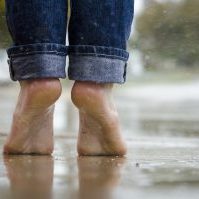Flat Feet

Flat Feet
You may have been born with flat feet, but that doesn’t mean you’re stuck with a lifetime of pain and discomfort. In fact, most cases of flat feet improve dramatically with simple, nonsurgical treatment. At Family Foot and Ankle Center in Niles and Berwyn, Illinois, board-certified podiatrist Shermi Parikh, DPM, and the rest of the team help you overcome flat feet, including through custom-made orthotics. To learn more, schedule an appointment online today or by phone today.
Flat Feet Q & A
What are flat feet?
Flat feet means an absence of a normal foot arch, so your entire foot touches the ground when you stand. This may happen because your arches don’t develop as they’re supposed to during early childhood. Alternately, your arches may develop normally but collapse in adulthood, which is known as “fallen arches.”
Flat feet may be “rigid” or “flexible.” If you have rigid flat feet, you never have visible arches. If you have flexible flat feet, your feet look flat when you’re standing, but your arches return when you’re not standing.
Flexible flat feet are common among children. Usually, kids outgrow that form of the condition by the time they are eight years old.
Not everyone experiences pain from flat feet or fallen arches. However, many people with flat feet do develop problems in their feet and ankles, including plantar fasciitis, tendonitis, and shin splints. You only need to seek treatment for flat feet if it causes other foot problems.
Complications usually happen because flat feet cause you to distribute your body weight unevenly. Similarly, people who have very high arches are also prone to foot pain and complications.
What causes flat feet?
Common causes of flat feet include:
- Genetics, passed from parents to children
- Rheumatoid arthritis, which can wear down the tendons in your feet
- Injuries to the foot or ankle
- Marfan syndrome, a genetic connective tissue disorder
- Damage to the posterior tibial tendon, which connects your calf muscle to the bones inside your feet
- Nervous system or muscle diseases
You’re more likely to develop flat feet in adulthood if you struggle with obesity, have diabetes, or are pregnant, which can place additional stress on the tendons in your feet.
How are flat feet diagnosed and treated?
To diagnose flat foot, your doctor asks about your symptoms, including foot pain and fatigue. They also examine your feet from the front and back, feel your hands and muscles, and may ask you to perform movements such as standing on your toes.
Depending on how much pain you’re experiencing, your doctor may also order an imaging test, which can detect arthritis or an injury to your tendons.
Treatment for flat feet involves managing pain and other symptoms, addressing any underlying conditions, and ensuring your feet have enough support. Your doctor can fit you for custom-made orthotics, or shoe inserts, to cushion and stabilize your feet.
If you have foot pain and think it's because of flat feet, call Family Foot and Ankle Center or schedule an appointment online today.
